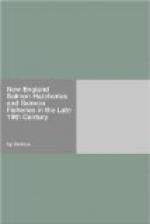Though not at all such water as would be chosen by a salmon at large, it nevertheless proved well adapted to the purpose of an inclosure for the breeding fish. It was shallow, its greatest depth, at the season of highest water, being but 10 feet; at its upper end it abuts against an extensive swamp, and almost its entire bottom, except close to the shore, is composed of a deposit of soft, brown, peaty mud of unknown depth. The water is strongly colored with peaty solutions, has a muddy flavor, and under the rays of a summer sun becomes warmed to 70° (Fahrenheit) at the very bottom.* Yet in such a forbidding place as this, salmon passed the summer in perfect health. There were some losses, but every reason to believe them all to have been caused by injuries received prior to their inclosure.
* During the month of August, 1872, the bottom temperature at 1 p.m. was never below 70°, and on six days was found to be 71°.
During and after the hottest term of each summer (the month of August) very few died.
The supply of salmon was obtained mainly, as in 1871, from the weirs in the southern part of Verona. They were placed in cars, specially fitted for the purpose; and towed to Bucksport on the flood tide. From the river to the inclosure they were hauled on drays in wooden tanks 3 feet long, 2 feet wide and 2 feet deep, half a dozen at once. From the weirs to the boats and from the boats to the tanks they were dipped in great canvas bags. From all this handling but few losses ensued.
In the establishment at Bucksport village the work was carried on for four years, from 1872 to 1876, with a fair degree of success. Then ensued a suspension till 1879, when the reappearance of salmon in the Merrimack, Connecticut, and some other rivers renewed the hopes of final success, and encouraged the commissioners to reopen the station. It had, however, been found that the old location had serious defects.
The inclosure was costly to maintain, and the recapture of the fish involved a great deal of labor and trouble. The water supplied to the hatchery was liable in seasons of little rain to be totally unfit, causing a premature weakening of the shell and very serious losses in transportation. After a careful search through the neighboring country it was found that the most promising site for an inclosure was in Dead Brook, near the village of Orland (though within the limits of the town of Bucksport), and for a hatchery no location was equal to Craigs Pond Brook, the spot where the original experiments were tried in 1871. The only serious drawback was the separation of the two by a distance of some 2 miles, which could not offset the positive advantage of the hatchery site. Accordingly the necessary leases were negotiated, an inclosure made in Dead Brook, and a stock of breeding salmon placed therein in June, 1879. Since then the work has been continued without interruption.
It is still found most convenient to obtain the stock of breeding salmon, as in the early years of the enterprise, from about a dozen weirs in the Penobscot River along the shores of the island of Verona. The fishermen are provided with dip-nets or bags with which to capture the fish in their weirs, with tanks or cars in which to transport them to the collecting headquarters, whither they are brought immediately after capturing, about low water.




